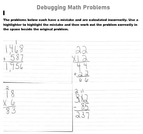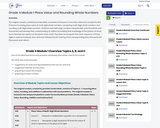
Mystery Numbers: Number Sense Mathematics Instructional Plan
- Subject:
- Mathematics
- Material Type:
- Lesson Plan
- Provider:
- VDOE
- Author:
- VDOE
- Date Added:
- 10/04/2024

Mystery Numbers: Number Sense Mathematics Instructional Plan

Rounding: Identifying the Range Mathematics Instructional Plan

Rounding Match Mathematics Instructional Plan

Multiplication: Fact Fluency Mathematics Instructional Plan

Multiplication: Fluency with Facts Mathematics Instructional Plan

Addition and Subtraction with Whole Numbers Mathematics Instructional Plan

Multiplying Two-Digit Numbers: Bridging from the Concrete to the Symbolic Mathematics Instructional Plan

Pears in a Basket: Dividing with Whole Numbers Mathematics Instructional Plan

Trip Transportation Task Template and Student Version of Task

Shopping for Thanksgiving Lunch: Computation Mathematics Instructional Plan

This is a cross-curricular activity that uses the story Alexander, Who Used to Be Rich Last Sunday to practice money and decimal skills in addition to reading and writing skills. After reading or hearing the story, students will complete the attached worksheet. (If it's read aloud, students would need a way to refer back to the story to answer the questions. The worksheet has a mixture of reading and math questions. It can be edited if you choose. It can be used for either 3rd or 4th grade. With slight modifications, it could also be used for middle school EL students to learn about currency.

Students locate and correct mistakes (bugs) in standard math algorithms.

The original module, created by Eureka Math, consisted of 19 lessons. It has been altered to include the first 10 lessons involving place value of multi-digit whole numbers, comparing multi-digit whole numbers, and rounding multi-digit whole numbers. Students work with large numbers using familiar units (hundreds and thousands) and develop their understanding of millions by building their knowledge of the pattern of times ten in the base ten system on the place value chart. They learn to recognize that each sequence of three digits is read as hundreds, tens, and ones followed by the naming of the corresponding base thousand unit (thousand, and million).

Just in Time Quick Check Nine-Digit Place Value

Just in Time Quick Check Compare and Order Whole Numbers

Just in Time Quick Check Round Whole Number

Just in Time Quick Check Multiplication Fact Fluency

Just in Time Quick Check Estimate and Determine Sums, Differences and Products

Just in Time Quick Check Estimate and Determine Quotients

Just in Time Quick Check Problem Solving